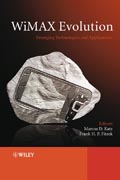
WiMAX is one of the most studied technologies today, and one of the strongestproponents for becoming the underlying technology of future high-performance wireless networks. Focusing on the future developments of WiMAX technology, this unique book covers most of the relevant evolutionary aspects of WiMAX, fromthe physical to the application layer, including visions from industry, standardization, and research community. Featuring a balanced mix of contributions from highly regarded professionals, WiMAX Evolution is an ideal reference for professionals in product development, research engineers and scientists, standardization engineers, professors, and advanced students. INDICE: Contents List of Contributors Foreword Preface Acknowledgements List of Acronyms I Introduction 1 Introduction to WiMAX Technology Wonil Roh andVladimir Yanover 1.1 Overview of State-of-the-artWiMAX Technology 1.2 WiMAXEvolutionPath References II WiMAX Validation: Validating Current Fixed and MobileWiMAX Through Advanced Testbeds 2 WiMAX Performance in Practice Kostas Pentikousis, Esa Piri, Jarno Pinola and Ilkka Harjula 2.1 EmpiricalEvaluationsofWiMAX 2.2 FixedWiMAXTestbedEvaluation 2.3 VoIPOverFixedWiMAX 2.4 IPTVoverfixedWiMAX 2.5 MobileWiMAXTestbedEvaluation 2.6 Summary 2.7 FurtherReading References .III Novel Scenarios 3 NovelWiMAX Scenarios for Future BroadbandWireless Access Networks Pedro Neves, Kostas Pentikousis, Susana Sargento, Marília Curado, Paulo Simões and Francisco Fontes 3.1 Introduction 3.2 WMANNetworkProvider 3.3 TelemedicineApplications 3.4 EnvironmentalMonitoring . 3.5 Conclusions References 4 Pricing in WiMAX Networks Ioannis Papapanagiotou, Jie Hui and Michael Devetsikiotis 4.1 Introduction 4.2 Economics in Network Engineering 4.3 BuildingthePricingSchemes 4.4 Pricing in DifferentWiMAX Topologies 4.5 Conclusion References IV Advanced WiMAX Architectures 5 WiMAX Femtocells Chris Smart, Clare Somerville and Doug Pulley 5.1 Introduction 5.2 Architectureof aWiMAXFemtocell 5.3 Femtocell Fundamentals 5.4 FemtocellMacrocell Interference References 6 Cooperative Principles in WiMAX Qi Zhang, Frank H.P. Fitzek and Marcos D. Katz 6.1 Introduction 6.2 Cooperative Diversity Schemes in Mobile Multihop Relay Based WiMAX (802.16j) 6.3 Cooperative Schemes for Multicast Broadcast Services inWiMAX . 6.4 Network Coding Implementation in the CommercialWiMAX Mobile Device 6.5 Conclusion References viii CONTENTS 7 The Role of WiMAX Technology in Distributed Wide Area Monitoring Applications Francesco Chiti, Romano Fantacci, Leonardo Maccari, Dania Marabissi and Daniele Tarchi 7.1 MonitoringwiththeWSNParadigm 7.2 OverallSystemArchitecture 7.3 Efficient Access Management Schemes 7.4 SecureCommunicationsApproaches References 8 WiMAX Mesh Architectures and Network Coding Parag S. Mogre, Matthias Hollick, Christian Schwingenschloegl, Andreas Ziller and Ralf Steinmetz 8.1 Introduction 8.2 Background on the IEEE 802.16 MeSH Mode 8.3 Design Principles for Network Coding in the IEEE 802.16 MeSH Mode 8.4 EnablingWNC for the IEEE 802.16 MeSH Mode 8.5 RelatedWork 8.6 ConclusionsandOutlook References 9 ASN-GWHigh Availability through Cooperative Networking in Mobile WiMAX Deployments Alexander Bachmutsky 9.1 Introduction 9.2 ClassicHAImplementation 9.3 Network-based Resiliency Solutions for Routing 9.4WiMAXNetworkElementsR4/R6HealthManagement 9.5 R6LoadBalancing 9.6 ASN-GWFailure andRecovery 9.7 N:N Redundancy 9.8 Multi-instance ASN-GW 9.9 The Proposal Summary 9.10 Conclusions V WiMAX Extensions 10 Robust Header Compression forWiMAX Femto Cells Frank H.P. Fitzek, Gerrit Schulte, Esa Piri, Jarno Pinola, Marcos D. Katz, Jyrki Huusko, Kostas Pentikousis and Patrick Seeling CONTENTS 10.1Introduction 10.2 ROHCinaNutshell 10.3 ScenarioUnder Investigation 10.4 WiMAXandROHCMeasurementSetup 10.5 WiMAXandROHCMeasurementsResults 10.6 Conclusion References 11 A WiMAX Cross-layer Framework for Next Generation Networks Pedro Neves, Susana Sargento, Ricardo Matos, Giada Landi, Kostas Pentikousis, Marília Curado and Francisco Fontes 11.1 Introduction 11.2 IEEE 802.16 Reference Model 11.3 Cross-layerDesignforWiMAXNetworks 11.4 WEIRD:APracticalCase ofWiMAXCross-layerDesign 11.5 WEIRDFrameworkPerformanceEvaluation 11.6 Summary References 12 Speech Quality Aware Resource Control for Fixed and Mobile WiMAX Thomas Michael Bohnert, Dirk Staehle and Edmundo Monteiro 12.1 Introduction 12.2 Quality of Experience versus Quality of Service Assessment 12.3 Methods for Speech Quality Assessment 12.4 Continuous Speech Quality Assessment for VoIP 12.5 Speech Quality Aware Admission Control for Fixed IEEE 802.16Wireless 12.6 The Idea of an R-score-basedScheduler 12.7 Conclusion References 13 VoIP overWiMAX Rath Vannithamby and Roshni Srinivasan 13.1 Introduction 13.2 Features to Support VoIP overWiMAX 13.3 EnhancedFeatures for ImprovedVoIPCapacity 13.4 SimulationResults 13.5 Conclusion References 14 WiMAX User Data Load Balancing Alexander Bachmutsky 14.1 Introduction 14.2 LocalBreakoutUse forLoadBalancing 14.3 Network-level Load Balancing over Tunneled Interfaces 14.4 Conclusions . 15 Enabling Per-flow and System-wide QoS and QoE in Mobile WiMAX Thomas Casey, Xiongwen Zhao, Nenad Veselinovic, Jari Nurmi and Riku Jäntti 15.1 Introduction 15.2 Overview 15.3 Per-flow-basedQoSandQoE 15.4 System-wideTools forEnablingQoSandQoE 15.5 Conclusions References VI WiMAX Evolution and Future Developments 16 MIMO Technologies forWiMAX Systems: Present and Future Chan-Byoung Chae, Kaibin Huang and Takao Inoue 16.1 Introduction 16.2 IEEE802.16e: Single-user MIMO Technologies 6.3 IEEE802.16m: Evolution Towards Multiuser MIMO Technologies Part I. NonlinearProcessing 16.4 IEEE802.16m: Evolution Towards Multiuser MIMO Technologies Part II. LinearProcessing 16.5 Conclusion References 17 Hybrid Strategies for Link Adaptation Exploiting Several Degrees of Freedom inWiMAX SystemsSuvra Sekhar Das, Muhammad Imadur Rahman and Yuanye Wang 17.1 Introduction 17.2 LinkAdaptationPreliminaries 17.3 LinkAdaptationAlgorithms 17.4 LinkAdaptationScenario 17.5 PowerAdaptationwithBitAdaptation 17.6 LinkAdaptationConsideringSeveralSystemIssues 17.7 Summary References 18 ApplyingWiMAX in New Scenarios: Limitations of the Physical Layer and Possible Solutions Ilkka Harjula, Paola Cardamone, Matti Weissenfelt, Mika Lasanen, Sandrine Boumard, Aaron Byman and Marcos D. Katz 18.1 WiMAXinNewScenarios 18.2 Channel Model for Mountainous Environments 18.3 Mountainous Scenario and Channel Modeling 18.4 BeamformingAlgorithmsandSimulation 18.5 A Timing Synchronization Study in a Mountain Environment . 18.6 Analysis andConclusions References 19 Application of Radio-over-Fiber in WiMAX: Results and Prospects Juan Luis Corral, Roberto Llorente, Valentín Polo, Borja Vidal, Javier Martí, Jonás Porcar, David Zorrilla and Antonio José Ramírez 19.1 Introduction 19.2 OpticalTransmissionofWiMAXSignals 19.3 WiMAX-on-FiberApplications 19.4 Conclusions References . CONTENTS 20 Network Planning and its Part in FutureWiMAX Systems 399 Avraham Freedman and Moshe Levin 20.1 Introduction 20.2 TheNetworkPlanningProcess 20.3 The ImpactofWiMAXonNetworkPlanning 20.4 PlanningofFutureWiMAXNetworks 20.5 Modeling: theKeytoIntegrationofPlanningInformation 20.6 Conclusions References 21 WiMAX Network Automation: Neighbor Discovery, Capabilities Negotiation, Auto-configuration and NetworkTopology Learning Alexander Bachmutsky 21.1 Introduction 21.2 WiMAXNetworkElementsAuto-discovery 21.3 Automatic Learning of the WiMAX Network Topology 21.4Capabilities Exchange 21.5 AutomaticWiMAXVersionManagement 21.6 AutomatedRoaming 21.7 Conclusion:NetworkAutomationas aWiMAXDifferentiator References 22 An Overview of Next GenerationMobile WiMAX: Technology and Prospects Sassan Ahmadi 22.1 Introduction 22.2 Summary of IEEE 802.16m System Requirements 22.3 Areasof ImprovementandExtensioninMobileWiMAX 22.4 IEEE 802.16m Architecture and Protocol Structure 22.5 IEEE 802.16m Mobile Station State Diagram 22.6 IEEE 802.16m Physical Layer 22.7 IEEE 802.16m MAC Layer 22.8 Conclusions References Index
- ISBN: 978-0-470-69680-4
- Editorial: John Wiley & Sons
- Encuadernacion: Cartoné
- Páginas: 504
- Fecha Publicación: 30/01/2009
- Nº Volúmenes: 1
- Idioma: Inglés
